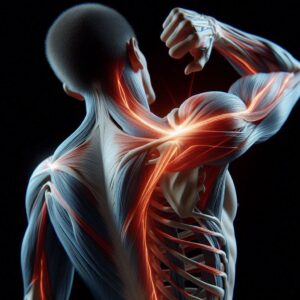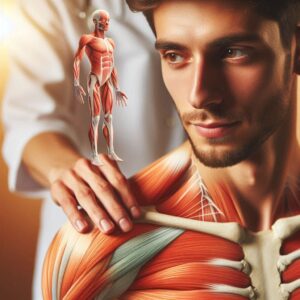Fascial Distortion Model: A Proven Approach to Treatment
The Fascial Distortion Model (FDM) is a diagnostic and treatment approach that emphasises identifying and rectifying distortions in the body's connective tissue, called fascia. Fascia is a complex network of collagen and elastin fibres that supports muscles, organs, and structures throughout the body. Fascia distortion can lead to various symptoms, including pain, limited movement, and dysfunction in the affected area.
The FDM was created by American osteopathic physician Stephen Typaldos, D.O., in the 1990s. Dr. Typaldos noted that conventional medical approaches did not adequately address many musculoskeletal injuries and conditions, prompting him to develop a groundbreaking model for understanding and tackling these issues. The FDM categorises fascial distortions into six distinct types, each displaying unique symptoms and patterns of dysfunction.
The categories encompass Triggerband, Continuum Distortion, Cylinder Distortion, Herniated Triggerpoint, Folding Distortion, and Tectonic Fixation. The FDM distinguishes itself by focusing on the identification and treatment of specific fascial distortions through hands-on techniques rather than relying solely on imaging or other diagnostic approaches. Skilled practitioners in the FDM utilise palpation and observation techniques to identify areas of distortion within the fascia, subsequently applying focused manual therapies to address these issues effectively.
The FDM targets the underlying fascial distortions to alleviate pain, enhance function, and restore mobility in the affected body areas.
Summary
- The Fascial Distortion Model (FDM) serves as a comprehensive diagnostic and treatment framework focused on identifying and managing specific types of fascial distortions within the body.
- Fascial distortions can be identified through a comprehensive physical examination and a detailed patient history assessment—these issues frequently present as discomfort, restricted mobility, or additional symptoms.
- Treatment methods for fascial distortions can include manual therapy techniques such as manipulation, myofascial release, and exercise and movement therapies.
- The Fascial Distortion Model presents numerous benefits, including improved pain relief, increased range of motion, and faster injury recovery.
- Case studies and success stories demonstrate the effectiveness of FDM in tackling various musculoskeletal conditions and injuries.
- Integrating the Fascial Distortion Model with supplementary treatment approaches, such as physiotherapy and chiropractic care, provides a comprehensive strategy for managing patient care.
- Finding a qualified expert for Fascial Distortion Model treatment is crucial, necessitating a search for healthcare professionals with specialised training and FDM experience.
 Identifying Fascial Distortions in the Body
Identifying Fascial Distortions in the Body
Assessment Techniques
Experts skilled in FDM employ palpation and observation methods to identify specific types of fascial distortions guided by unique symptoms and patterns of dysfunction. For example, a Trigger and distortion can present as a taut, rope-like band of tissue that causes sharp, shooting pain with movement. Conversely, cylinder distortion can manifest as a swollen, sausage-shaped area of tissue that restricts movement and leads to aching or throbbing discomfort.
Assessment of Mobility and Diagnostic Imaging
In addition to palpation and observation, practitioners may employ movement assessments to identify areas of fascial distortion. By meticulously observing patients' movements and how they perform tasks, practitioners can pinpoint areas of restricted mobility or dysfunctional movement patterns that may indicate underlying fascial distortions. Imaging studies, such as MRI or ultrasound, may be employed to confirm the presence of fascial distortions in specific cases; however, these methods are not always necessary for diagnosis.
Attention and Rehabilitation
Upon recognising fascial distortions, practitioners can develop a customised treatment plan that specifically targets these issues through focused manual therapies. These therapies may include techniques such as trigger and release, cylinder distortion reduction, or tectonic fixation reduction, all designed to precisely address each type of fascial distortion. By addressing these distortions, practitioners aim to relieve pain, improve function, and restore mobility in the affected area.
Treatment Techniques for Fascial Distortions
The treatment techniques utilised in the Fascial Distortion Model are based on precise manual therapies designed to address each type of fascial distortion specifically. These techniques encompass practical methods such as soft tissue manipulation, stretching, and mobilisation to relieve tension, reduce swelling, and restore normal function in the affected area. For example, Triggerband release techniques may involve applying pressure and stretching to the specific area to relieve tight tissue bands and reduce discomfort. Conversely, strategies for lowering cylinder distortion may employ gentle compression and mobilisation to alleviate swelling and improve mobility.
In addition to these specialised techniques, experts trained in FDM may integrate supplementary therapies such as ice or heat application, electrical stimulation, or therapeutic exercise to amplify the advantages of manual treatment and promote healing in the affected area. These complementary therapies are employed with manual techniques to address pain, inflammation, and dysfunction associated with fascial distortions. Treatment techniques in the FDM are tailored to each patient, considering their type of fascial distortion, individual symptoms, and patterns of dysfunction.
This customised approach allows professionals to effectively address the underlying pain and dysfunction issues, leading to enhanced patient results.
 Benefits of the Fascial Distortion Model
Benefits of the Fascial Distortion Model
The Fascial Distortion Model offers various benefits for those seeking relief from musculoskeletal pain and dysfunction. The FDM provides a notable benefit by focusing on the identification and treatment of specific fascial distortions that conventional medical approaches may overlook or misdiagnose. By tackling these core issues, the FDM aims to provide more effective relief from pain and dysfunction than traditional treatments, which frequently concentrate only on symptoms rather than addressing the root cause.
The FDM offers a significant benefit by emphasising practical manual therapies, which can provide immediate pain relief and improve functionality in the affected area. Many patients experience significant pain relief and improved mobility after just one or two sessions with a practitioner experienced in the FDM approach. This prompt response to treatment can be especially beneficial for those who have experienced chronic pain or limited mobility for an extended period.
FDM offers a customised treatment strategy that considers each patient's unique symptoms and dysfunction patterns. By tailoring treatment approaches to address specific types of fascial distortions in each individual, practitioners proficient in FDM can provide more targeted and effective care that addresses the underlying causes of pain and dysfunction.
Case Studies and Success Stories
Many case studies and success stories illustrate the efficacy of the Fascial Distortion Model in relieving musculoskeletal pain and dysfunction. A case study published in the Journal of Bodywork and Movement Therapies presented a patient experiencing chronic low back pain who achieved significant relief after just two sessions of FDM treatment. The patient had pursued various conventional therapies without attaining the expected outcomes. Following FDM treatment targeting specific fascial distortions in the lower back, they reported a notable reduction in pain and improved mobility.
A case study published in the International Journal of Osteopathic Medicine examined a patient experiencing shoulder pain and restricted range of motion. A notable enhancement was observed after FDM treatment, which focused on correcting a cylinder distortion in the shoulder girdle. The patient reported significant pain relief and improved functionality after just one session of FDM treatment, underscoring the rapid effectiveness of the targeted manual therapies utilised in FDM. This compilation of case studies and success stories highlights the potential for fast relief from musculoskeletal pain and dysfunction through targeted manual therapies based on the Fascial Distortion Model.
People dealing with chronic pain or limited mobility can find significant relief and improved function after receiving FDM treatment from a qualified professional.
Integrating the Fascial Distortion Model with Other Treatment Modalities
Collaborative Assistance
Experts trained in the FDM often collaborate with other healthcare professionals, such as physiotherapists, chiropractors, and osteopaths, to develop a customised treatment plan that thoroughly addresses a patient's condition.
Enhanced Treatment Outcomes
Combining the FDM with other evidence-based therapies, such as therapeutic exercise, chiropractic adjustments, or acupuncture, enables patients to achieve enhanced treatment outcomes and ongoing healing and recovery. This detailed approach can improve outcomes by addressing the complex needs of musculoskeletal pain and dysfunction individuals.
Tailored Treatment Solutions
Integrating FDM with supplementary modalities provides patients with an expanded range of treatment options, enabling tailored solutions to address their needs and conditions. Individuals facing intricate musculoskeletal challenges may benefit from integrating FDM treatment with physiotherapy to address strength and mobility deficits or combining it with acupuncture to reduce pain and inflammation.
 Finding a Qualified Practitioner for Fascial Distortion Model Treatment
Finding a Qualified Practitioner for Fascial Distortion Model Treatment
Individuals looking for alleviation from musculoskeletal pain and dysfunction should seek out a qualified practitioner in the Fascial Distortion Model treatment. Individuals with advanced training in FDM have the knowledge and skills to identify specific fascial distortions and apply targeted manual therapies to address these issues efficiently. When seeking a qualified practitioner for FDM treatment, patients should look for healthcare providers who have completed advanced training in FDM from reputable organisations, such as the American Fascial Distortion Model Association (AFDMA) or other recognised training institutions.
These courses provide practitioners with a comprehensive understanding of FDM principles, effective assessment techniques, and customised treatment protocols designed for each type of fascial distortion. Patients can receive referrals from their primary care physician or other healthcare professionals to locate qualified practitioners offering FDM treatment in their area. Additionally, online directories or industry associations may provide listings of practitioners who have completed advanced training in the FDM and are qualified to offer this specialised form of care.
Choosing a qualified expert for FDM treatment enables patients to receive customised manual therapies designed to address their specific fascial distortions, promoting rapid alleviation of musculoskeletal pain and dysfunction. This tailored care method can lead to more effective results for those seeking relief from chronic pain or limited mobility.
FAQs
What does the fascial distortion model (FDM) treatment entail?
The fascial distortion model (FDM) is a manual therapy approach designed to identify and relieve musculoskeletal pain and dysfunction by addressing distortions in the body's connective tissue, called fascia.
What is the mechanism behind FDM treatment?
FDM treatment employs precise manual techniques to successfully release and realign distorted fascial tissues, relieve pain, improve mobility, and restore
Which conditions can FDM treatment assist with?
FDM treatment is commonly employed to address a range of musculoskeletal concerns, including back pain, neck pain, joint pain, sports injuries, and repetitive strain injuries.
Is FDM treatment appropriate for all individuals?
FDM treatment may not be suitable for everyone. It is essential to consult with a qualified healthcare expert to evaluate its appropriateness for your specific condition and medical history.
What potential side effects might arise from FDM treatment?
FDM treatment is generally considered safe; however, some individuals may experience temporary soreness or discomfort following a session. It is crucial to address any concerns with a qualified practitioner before undergoing FDM treatment.
What is the usual number of FDM treatment sessions required?
The number of FDM treatment sessions needed can vary depending on the individual and the details of their condition. Some individuals may observe significant improvement after just a few sessions, while others may require ongoing treatment to achieve their desired outcomes.
Brought To You By:
The Article: Fascial Distortion Model: Effective FDM Treatment appeared first on https://mcrtherapies.co.uk
The Article Fascial Distortion Model: Effective FDM Treatment appeared first on https://mcrtherapies.com
The Article Fascial Distortion Model: Effective FDM Treatment Was Found On https://limitsofstrategy.com
Comments are closed